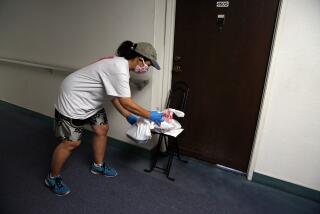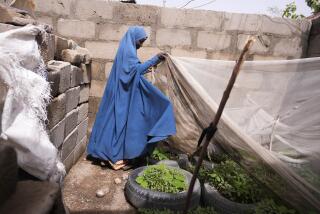‘Super Snacks’ Saving Filipinos : Islanders Poor, Hungry as Sugar Industry Crumbles
BACOLOD, Philippines — The color and noise of an election campaign filled the sun-baked streets beyond the walls, but inside the malnutrition ward, all was muted--quiet footfalls, hushed voices, faint hopes.
On one of the 18 beds, a girl of 6 sat blinking in the filtered light. “Night blindness,” Dr. Dan Duenas said, “a lack of Vitamin A.”
The only strong sensation in the room was the smell of sick children.
In a chair in the corner, Rena Pasaylo drowsed in the arms of her aunt. Rena has third-degree malnutrition. She is 1 year old and weighs 9 1/2 pounds, the birth weight of some American children. She should weigh 22, the doctors say.
Her mother collects and sells shellfish in Cadiz, here on the island of Negros. The father has tuberculosis and can no longer work. They have two other daughters, both sickly and one mute, the aunt said.
President Ferdinand E. Marcos campaigned for reelection here in Bacolod last week, promising vast infusions of government money to get the Negros sugar industry, the mainstay of the local economy, back on its feet.
Corazon Aquino, his opponent in today’s presidential election, was here earlier, pledging to break up the monopolistic practices that have hurt the crop on which the island depends.
But the poverty that brings malnutrition plagued Negros long before Marcos, even before the Americans who helped make sugar king here. In the Spanish colonial days of the last century, the people of Bacolod lived on fishing, a seasonal and chancy occupation even now.
“I must point out that what we are trying to do here is stopgap,” said Roque Hofilena Jr., who coordinates feeding programs for the planning and development office of the province of Negros Occidental.
His Bacolod office was lined with tilting mountains of “super-snack” boxes, a food supplement supplied through UNICEF, the United Nations Children’s Fund. Once a day, at sugar farms, shantytowns and rural barrios, government, church and private organizations are trying to hold back the tide of malnutrition with feeding programs.
According to a 1985 report issued by Hofilena’s office, the infant mortality rate in Negros Occidental has been consistently higher than those for the region and for the Philippines as a whole. Two-thirds of the children age 6 and under suffer some degree of malnutrition.
In 1985, said Duenas, the malnutrition ward doctor at the provincial hospital, one-fourth of the nearly 800 children admitted for treatment of malnutrition and complications died.
“We had two or three deaths last week,” he noted calmly.
The impoverished children of Negros are not dying of starvation, unlike the victims of the Ethiopian drought. The killer here is disease that attacks bodies weakened by hunger and an imbalanced diet.
10% Have Kwashiorkor
The provincial hospital can find room only for third-degree malnutrition cases, the most serious. One in 10 of these have kwashiorkor, an extreme stage characterized by anemia and distended bellies.
Some parents cannot afford to take their dying children to the hospital. Transportation costs too much. “Many small households are just forced to watch their kin die,” said Violeta Lopez-Gonzaga, director of Bacolod’s La Salle Social Research Center.
Duenas and Hofilena say recent statistics indicate a slight leveling in the incidence of serious malnutrition cases in the Bacolod area, an improvement attributed to feeding and education programs. But as long as poverty is the lot of the Negrenses, hunger will dominate their lives.
In Barangay 14, a slum neighborhood on the coast, Romeo Federez, 52, heads a a three-room household of 10 people.
Earns $5.50 a Week
He earns an average of 100 pesos a week (about $5.50) as a truck driver for a shipping company. Two sons-in-law supplement the family income with odd jobs. Breakfast, sometimes skipped, is vegetables. Lunch is rice and vegetables. For dinner, it’s rice again and perhaps 10 pesos worth of fish.
“And once in a rare while we can afford a few ounces of meat, chicken or pork,” Federez said. As he spoke in the dark shadows of his main room, a daughter held a malnourished child nearby.
The people of Barangay 14 plant vegetables on any available land, which helps to hold down food costs. Some buy fish from commercial boats and peddle them in the streets. A day’s work might net 20 pesos, about a dollar.
Juan Marquez, the Barangay leader, said that half of the 3,000 people are jobless. Ninety percent of the homes have electricity, he said, but none have indoor toilets or running water.
Idle youths play basketball on the Barangay court. Marquez, perhaps inured to the problems of hunger and sanitation, said, “Marijuana is our biggest trouble here.”
Seeking Solution
Hofilena in the provincial planning office, Father Iraneo Gordoncillo of the Roman Catholic Church’s social action center and Anita Rabago of the city’s department of social services are trying to find a short-term solution to Bacolod’s health problems, along with smaller, private programs.
Duplication of effort has been a problem but is being resolved, Hofilena said.
His program breaks down in four parts: direct feeding of malnourished children, promotion of home vegetable gardens, teaching mothers how to use their resources more effectively and health care and sanitation.
It is a new program, started last year, and is trying to solve an immediate problem, a saddening symptom of the province’s deeper troubles.
In the last two years, the sugar industry, the direct or indirect employer of seven out of ten people here, has come close to collapse, the victim of a worldwide glut and bad management in the Philippines.
Businesses Closed
Unemployed sugar workers have rimmed Bacolod with squatter towns. For those who stay on the farms, the work year gets shorter. In the city, businesses that supply the farms and their workers have shut down.
A pattern of life has been overturned. Nowhere in the Philippines was the feudal system more entrenched than in Negros. Hacienda owners and their workers were dependent upon each other. Generation of families stayed on the same farm.
“In the old days, government didn’t even have to go onto the haciendas,” said Hofilena. “The patron provided everything.”
No longer. A few owners have simply abandoned their land. Some workers, confused and angered by the break in traditional ties, have become recruits of the Communist-led New People’s Army, which is growing rapidly in Negros.
“The mass of Bacoleno poor see nothing in the future but a rapid slide down the bottom end of the life ladder,” Lopez-Gonzaga wrote in a recent study. “With no hope in sight, the classic picture of the docile poor is rapidly changing into a cynical, embittered and militant class.”
‘Feeding Is Not Enough’
“We are in danger of creating a macro-ward of indigents,” she said this week. “The way the social fabric is unraveling a traditional politician cannot read it or just doesn’t care to. Feeding is not enough. Feeding without a livelihood program is a bottomless pit.”
Lopez-Gonzaga and many others here see agricultural diversification and industrialization as the only way to break the chain of poverty and hunger.
“Everybody here is ready to shift gears,” she said, but capital has dried up in sugar country.
While politicians, insurgents and sociologists look to the long run, the operators of the feeding program work day to day, never sure when the government money and private charity will give out.
At Hacienda San Antonia outside Bacolod, 35 malnourished children gathered Tuesday for the daily feeding. First the monthly weighing was done. Carla de Quillo, 26 months old, was placed in a canvas seat attached to a metal balance rod slung from a beam. Her eyes swollen both by tears and third-degree malnutrition, she bawled loudly as a weight was placed on the other end of the rod.
Some Progress Seen
She weighed 15 1/2 pounds, up two from last month’s weighing, showing progress under the feeding program.
Fifteen-month-old Charmy Grace Occena was too weak to walk last month, a program worker said. Now she can take a few steps, but she never left her mother’s arms during the feeding.
The 35 malnourished children of Hacienda San Antonia’s 100 worker families gathered around a long table for the midday meal. Some had not eaten since the night before, their mothers said.
A mixture from the UNICEF super-snack pack--ground mung beans, rice, cocoa and Vitamin A--was mixed with water and sugar and placed in eight-ounce glasses.
The children scooped it out with spoons, never stopping until their glasses were empty.
“You destroy human dignity with feeding programs,” Duenas said. “The people will think this is part of their normal lives.”
For now, in Negros Occidental, it is .
Related stories on Page 26.
More to Read
Sign up for Essential California
The most important California stories and recommendations in your inbox every morning.
You may occasionally receive promotional content from the Los Angeles Times.










